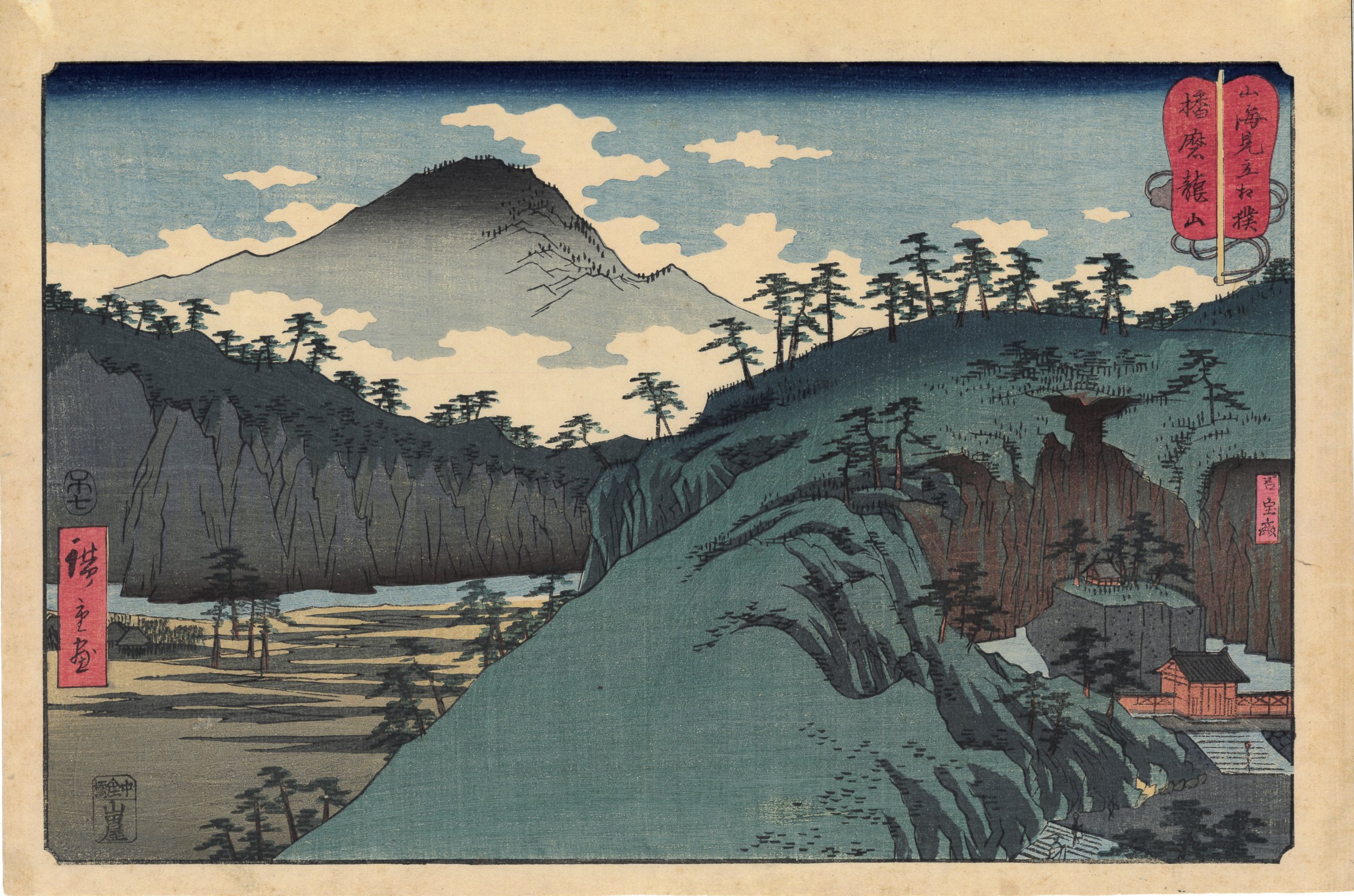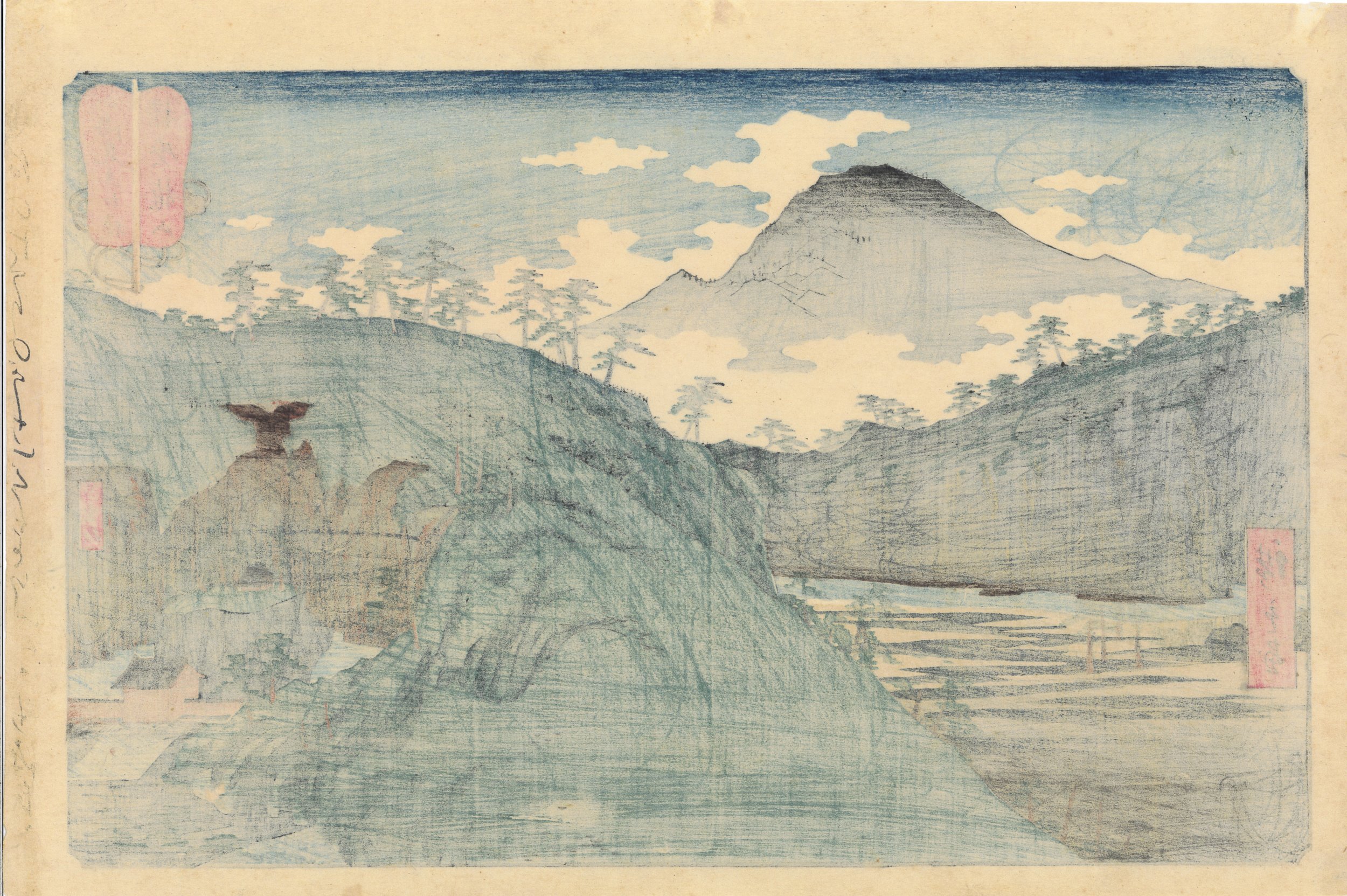Hiroshige | Harima Tatsuyama, Wrestling Matches between Mountains and Seas
歌川広重 Utagawa Hiroshige (1797-1858)
山海见立相撲 播磨竜山
Harima Tatsuyama, from the series of Wrestling Matches between Mountains and Seas
1858
木版画 | 横绘大判 | 25.3cm x 37.5cm
Woodblock-print | Oban Yoko-e | 25.3cm x 37.5cm
早期版次;颜色保存完好;画面上方角落纸张较薄;右边边缘黏贴了一层纸张
Early impression; slighty thinning to paper on top corners; extra paper added to right margin.
The title of Hiroshige’s many series were often straightforward – “The 53 Stations of the Tokaido,” “100 Famous Views of Edo,” for example. Being obscure or overly poetic was not in the publisher’s best interest if the goal selling landscape prints of specific locations. But in one of his last collections of designs, Hiroshige engaged in some fun conceptual wordplay and imagery.
The series “A Wrestling Match between Mountains and Seas,” published in the year of Hiroshige’s death, 1858, features towering mountains juxtaposed with the flatness of the nearby seas. A remarkable 140 prints with 70 views each of mountains and sea arond Japan were planned, but in the end, only 20 were comleted — 10 of the sea and 10 of mounains. The title cartouche of the series is in the shape of a fan used by a referee in a Sumo match. Some call this, “The Sumo Series.”
Unlike many of Hiroshige’s last works, which were in an upright tate-e format, this series reverted to a horizontal yoko-e format, like many of his earlier efforts. But unlike those series, here we see late-Edo quality color and printing: there are bright yellows and reds, and much luxurious bokashi.
This print depicts Harima Province in southern Honshu, Japan’s main island. It’s a dramatic image, with mountains rising up into the mist and clouds. This might seem exaggerated, but as anyone who’s travelled around Japan knows, much of the countryside actually looks like this.
This print is in good condition. While it’s not been re-margined, some paper has been expertly added to the right side.
Interested in purchasing?
Please contact us.
歌川広重 Utagawa Hiroshige (1797-1858)
山海见立相撲 播磨竜山
Harima Tatsuyama, from the series of Wrestling Matches between Mountains and Seas
1858
木版画 | 横绘大判 | 25.3cm x 37.5cm
Woodblock-print | Oban Yoko-e | 25.3cm x 37.5cm
早期版次;颜色保存完好;画面上方角落纸张较薄;右边边缘黏贴了一层纸张
Early impression; slighty thinning to paper on top corners; extra paper added to right margin.
The title of Hiroshige’s many series were often straightforward – “The 53 Stations of the Tokaido,” “100 Famous Views of Edo,” for example. Being obscure or overly poetic was not in the publisher’s best interest if the goal selling landscape prints of specific locations. But in one of his last collections of designs, Hiroshige engaged in some fun conceptual wordplay and imagery.
The series “A Wrestling Match between Mountains and Seas,” published in the year of Hiroshige’s death, 1858, features towering mountains juxtaposed with the flatness of the nearby seas. A remarkable 140 prints with 70 views each of mountains and sea arond Japan were planned, but in the end, only 20 were comleted — 10 of the sea and 10 of mounains. The title cartouche of the series is in the shape of a fan used by a referee in a Sumo match. Some call this, “The Sumo Series.”
Unlike many of Hiroshige’s last works, which were in an upright tate-e format, this series reverted to a horizontal yoko-e format, like many of his earlier efforts. But unlike those series, here we see late-Edo quality color and printing: there are bright yellows and reds, and much luxurious bokashi.
This print depicts Harima Province in southern Honshu, Japan’s main island. It’s a dramatic image, with mountains rising up into the mist and clouds. This might seem exaggerated, but as anyone who’s travelled around Japan knows, much of the countryside actually looks like this.
This print is in good condition. While it’s not been re-margined, some paper has been expertly added to the right side.
Interested in purchasing?
Please contact us.
歌川広重 Utagawa Hiroshige (1797-1858)
山海见立相撲 播磨竜山
Harima Tatsuyama, from the series of Wrestling Matches between Mountains and Seas
1858
木版画 | 横绘大判 | 25.3cm x 37.5cm
Woodblock-print | Oban Yoko-e | 25.3cm x 37.5cm
早期版次;颜色保存完好;画面上方角落纸张较薄;右边边缘黏贴了一层纸张
Early impression; slighty thinning to paper on top corners; extra paper added to right margin.
The title of Hiroshige’s many series were often straightforward – “The 53 Stations of the Tokaido,” “100 Famous Views of Edo,” for example. Being obscure or overly poetic was not in the publisher’s best interest if the goal selling landscape prints of specific locations. But in one of his last collections of designs, Hiroshige engaged in some fun conceptual wordplay and imagery.
The series “A Wrestling Match between Mountains and Seas,” published in the year of Hiroshige’s death, 1858, features towering mountains juxtaposed with the flatness of the nearby seas. A remarkable 140 prints with 70 views each of mountains and sea arond Japan were planned, but in the end, only 20 were comleted — 10 of the sea and 10 of mounains. The title cartouche of the series is in the shape of a fan used by a referee in a Sumo match. Some call this, “The Sumo Series.”
Unlike many of Hiroshige’s last works, which were in an upright tate-e format, this series reverted to a horizontal yoko-e format, like many of his earlier efforts. But unlike those series, here we see late-Edo quality color and printing: there are bright yellows and reds, and much luxurious bokashi.
This print depicts Harima Province in southern Honshu, Japan’s main island. It’s a dramatic image, with mountains rising up into the mist and clouds. This might seem exaggerated, but as anyone who’s travelled around Japan knows, much of the countryside actually looks like this.
This print is in good condition. While it’s not been re-margined, some paper has been expertly added to the right side.
Interested in purchasing?
Please contact us.
Utagawa Hiroshige (1797-1858)
Ando Hiroshige (1897-1858) revolutionized the art of landscape prints during the Edo era, building on the success of his senior, Hokusai, but taking a more poetic and naturalist approach to portraying the beauty of Japan.
The son of a low-level Samurai assigned to the fire brigade in Edo, Hiroshige became a student of the Utagawa school as a young man. His first prints focused on beautiful women (bijin), and views of Edo. But in 1833 he began work on his most famous early work, his first series depicting the Tokaido, the "Great Sea Road" between Edo and Tokyo.
Today there is some controversy about this series. Initially, it was believed that Hiroshige had travelled the route along with a local lord (Daimyo) who was making a gift of horses to the Emperor. But more recent scholarship suggests Hiroshige never travelled the road himself, at least not the entire way, and made his designs using published guidebooks.
Nonetheless, the prints were wonderful and revolutionary. They embraced the seasons with a gentle lyricism missing from Hokusai's striking but stylized depictions. In Hiroshige's work, nature is sacred -- but it is always mixed with humanity, with travelers or little inns or bridges. There is a magical harmony between man and the elements.
His depiction of the seasons and weather is especially evocative. Snow blankets some views with a hushed silence, while rain streaks down furiously in others. In some prints natured is agitated; in others, calm prevails. Produced in a horizontal oban yoko-e format, the series was a smash hit.
The Tokaido series made Hiroshige famous, and he became incredible prolific. In the 1840s he produced many strong designs, but many mediocre ones, too, including several subsequent Tokaido series of varying quality.
In 1853, however, he made a big step. He turned his landscapes sideways, embracing a bold vertical oban tate-e format. This gave his designs new energy and a modern feel. The first of these was Famous Views of the Sixty-Odd Provinces. From them on, most of his most noted series were executed in this format.
He saved his greatest for his last. In 1856 he began work on 100 Famous Views of Edo, which many consider his most exceptional work. Here his home city was portrayed with energy and passion, and in these 119 designs he created an incredible record of a vanished place. In addition to the striking vertical format, he developed exciting new compositions, often juxtaposing a strong foreground element with a distant background.
Among the many famous images in this series are Squall at Ohashi and the Plum Garden in Komeido. Both of these were copied by Vincent Van Gogh, a great admirer of Hiroshige. Thus, the great Japanese artist had a profound effect on Western art.
Alas, his beloved Edo ended his life. Hiroshige was claimed by a cholera epidemic that swept the city in 1958. His pupil Shigenobu, who took the name Hiroshige II, completed The Famous Views of Edo.


